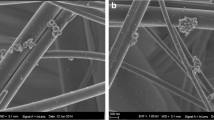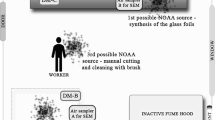Abstract
Nano reference values (NRVs) for occupational use of nanomaterials were tested as provisional substitute for Occupational Exposure Limits (OELs). NRVs can be used as provisional limit values until Health-Based OELs or derived no-effect levels (DNEL) become available. NRVs were defined for 8 h periods (time weighted average) and for short-term exposure periods (15 min-time weighted average). To assess the usefulness of these NRVs, airborne number concentrations of nanoparticles (NPs) in the workplace environment were measured during paint manufacturing, electroplating, light equipment manufacturing, non-reflective glass production, production of pigment concentrates and car refinishing. Activities monitored were handling of solid engineered NPs (ENP), abrasion, spraying and heating during occupational use of nanomaterials (containing ENPs) and machining nanosurfaces. The measured concentrations are often presumed to contain ENPs as well as process-generated NPs (PGNP). The PGNP are found to be a significant source for potential exposure and cannot be ignored in risk assessment. Levels of NPs identified in workplace air were up to several millions of nanoparticles/cm3. Conventional components in paint manufacturing like CaCO3 and talc may contain a substantial amount of nanosized particulates giving rise to airborne nanoparticle concentrations. It is argued that risk assessments carried out for e.g. paint manufacturing processes using conventional non-nano components should take into account potential nanoparticle emissions as well. The concentrations measured were compared with particle-based NRVs and with mass-based values that have also been proposed for workers protection. It is concluded that NRVs can be used for risk management for handling or processing of nanomaterials at workplaces provided that the scope of NRVs is not limited to ENPs only, but extended to the exposure to process-generated NPs as well.








Similar content being viewed by others
Notes
The Chemical Agents Directive (CAD), are Council Directives on the protection of the health and safety of workers from the risks related to chemical agents at work (98/24/EC), and on the protection of workers from the risks related to exposure to carcinogens and mutagens at work (2004/37/EC).
CMAR Carcinogenic, mutagenic, asthmagenic, reproduction toxic.
Rijksinstituut voor Volksgezondheid en Milieu (National Institute for Public Health and the Environment).
By soft regulation we understand sustainable rules of conduct which in principle have no legally binding force, but which nevertheless have effects in regulatory practice to achieve certain policy goals. Hard regulation refers to rules of conduct that are based on legal authority. Soft regulation includes standards, codes of conduct, and benchmarks etc. It can be established by private and public organizations.
References
Abbott LC, Maynard AD (2010) Exposure assessment approaches for engineered nanomaterials. Risk Anal 30(11):1634–1644
Aschberger K, Christensen FM (2010) Approaches for establishing human health no effect levels for engineered nanomaterials. J Phys. doi:10.1088/1742-6596/304/1/012078
Auffan M, Rose J, Bottero JY, Lowry GV, Jolivet JP, Wiesner MR (2009) Towards a definition of inorganic nanoparticles from an environmental, health and safety perspective. Nat Nanotechnol 4:634–641
Bermudez E, Mangum JB, Wong BA, Asgharian B, Hext PM, Warheit DB, Everitt JI (2004) Pulmonary responses of mice, rats, and hamsters to subchronic inhalation of ultrafine titanium dioxide particles. Toxicol Sci 77:347–357
BéruBé K, Balharry D, Sexton K, Koshy L, Jones T (2007) Combustion-derived nanoparticles: mechanisms of pulmonary toxicity. Clin Exp Pharmacol Physiol 34(10):1044–1050
Borm PJA, Robbins D, Haubold S, Kuhlbusch T, Fissan H, Donaldson K, Roel S, Stone V, Kreyling W, Lademann J, Krutmann J (2006) The potential risks of nanomaterials: a review carried out for ECETOC. Part Fibre Toxicol 3:11
Brouwer D (2010) Exposure to manufactured nanoparticles in different workplaces. Toxicology 269:120–127
Brouwer D, van Duuren-Stuurman B, Berges M, Jankowska E, Bard D, Mark D (2009) From workplace air measurement results toward estimates of exposure? Development of a strategy to assess exposure to manufactured nano-objects. J Nanopart Res 11:1867–1881
BSI (2007) BSI-British Standards. Guide to safe handling and disposal of manufactured nanomaterials. Nanotechnologies—Part 2. PD 6699-2:2007 BSI (2007). http://www.bsigroup.com/en/sectorsandservices/Forms/PD-6699-2/Download-PD6699-2-2007/. Accessed 29 April 2011
Choi HS, Ashitate Y, Lee JH, Kim SH, Matsui A, Insin N, Bawendi MG, Semmler-Behnke M, Frangioni JV, Tsuda A (2010) Rapid translocation of nanoparticles from the lung airspaces to the body. Nat Biotechnol 28:1300–1304
Dekkers S, de Heer C (2010) Tijdelijke nano-referentiewaarden. RIVM Rapport 601044001/2010. http://docs.minszw.nl/pdf/190/2010/190_2010_3_14399.pdf
Donaldson K, Tran L, Jimenez LA, Duffin R, Newby DE, Mills N, MacNee W, Stone V (2005) Combustion-derived nanoparticles: a review of their toxicology following inhalation exposure. Part Fibre Toxicol 2:10. doi:10.1186/1743-8977-2-10
Dorbeck-Jung B (2011) Soft regulation and responsible nanotechnological development in the European Union: Regulating occupational health and safety in the Netherlands. Eur J Law Technol 2(3):1–14
EC (2011) Commission recommendation of 18 October 2011 on the definition of nanomaterial (2011/696/EU).L Official Journal of the European Union 275/38 20.10.2011. http://eur-lex.europa.eu/LexUriServ/LexUriServ.do?uri=OJ:L:2011:275:0038:0040:EN:PDF
ECHA (2008) Guidance on information requirements and chemical safety assessment. Chap. 14. Occupational exposure estimation
Evans DE, Heitbrink WA, Slavin TJ, Peters TM (2008) Ultrafine and respirable particles in an automotive grey iron foundry. Ann Occup Hyg 52(1):9–21
Göhler D, Stintz M, Hillemann L, Vorbau M (2010) Characterization of nanoparticle release from surface coatings by the simulation of a sanding process. Ann Occup Hyg 54(6):615–624
Heitbrink WA, Evans DE, Ku BK, Maynard AD, Slavin TJ, Peters TM (2009) Relationships among particle number, surface area, and respirable mass concentrations in auto- motive engine manufacturing. J Occup Environ Hyg 6:19–31. doi:10.1080/15459620802530096
Hesterberg TW, Long CM, Lapin CA, Hamade AK, Valberg PA (2010) Diesel exhaust particulate (DEP) and nanoparticle exposures: what do DEP human clinical studies tell us about potential human health hazards of nanoparticles? Inhal Toxicol 22(8):679–694
IFA (2009) Institut für Arbeitsschutz der Deutschen Gesetzlichen Unfallversicherung, criteria for assessment of the effectiveness of protective measures. http://www.dguv.de/ifa/en/fac/nanopartikel/beurteilungsmassstaebe/index.jsp. Accessed 29 April 2011
Kreyling WG, Hirn S, Schleh C (2010) Nanoparticles in the lung. Nat Biotechnol 28(12):1275–1276
Lee JH, Kwon M, Ji JH, Kang CS, Ahn KH, Han JH, Yu IJ (2011) Exposure assessment of workplaces manufacturing nanosized TiO2 and silver. Inhal Toxicol 23(4):226–236
Marra J, Voetz M, Kiesling HJ (2010) Monitor for detecting and assessing exposure to airborne nanoparticles. J Nanopart Res 12:21–37
Murphy FA, Poland CA, Duffin R, Al-Jamal KT, Ali-Boucetta H, Nunes A, Byrne F, Prina-Mello A, Volkov Y, Li S, Mather SJ, Bianco A, Prato M, MacNee W, Wallace WA, Kostarelos K, Donaldson K (2011) Length-dependent retention of carbon nanotubesin the pleural space of mice initiates sustained inflammation and progressive fibrosis on the parietal pleura. Am J Pathol 178(6):2587–2600
NIOSH (2010) Occupational exposure to carbon nanotubes and nanofibers. Curr Intell Bull 161-A:1–149
NIOSH (2011) Occupational exposure to titanium dioxide. Curr Intell Bull 63:1–119. DHHS (NIOSH) Publication No. 2011–160
Oberdorster G, Oberdorster E, Oberdorster J (2004) Nanotoxicology: an emerging discipline evolving from studies of ultrafine particles. Environ Health Perspect 113(7):823–839
Pauluhn J (2010) Poorly soluble particulates: searching for a unifying denominator of nanoparticles and fine particles for DNEL estimation. Toxicology 279(1–3):176–188
Peters TM, Heitbrink WA, Evans DE, Slavin TJ, Maynard AD (2006) The mapping of fine and ultrafine particle concentrations in an engine machining and assembly facility. Ann Occup Hyg 50(3):249–257
Plitzko S (2009) Workplace exposure to engineered nanoparticles. Inhal Toxicol 21(S1):25–29
Poland CA, Duffin R, Kinloch I, Maynard A, Wallace WA, Seaton A, Stone V, Brown S, MacNee W, Donaldson K (2008) Carbon nanotubes introduced into the abdominal cavity of mice show asbestos-like pathogenicity in a pilot study. Nat Nanotechnol 3:423–428
Ramachandran G, Ostraat M, Evans DE, Methner MM, O’Shaughnessy P, D’Arcy J, Geraci CL, Stevenson E, Maynard A, Rickabaugh K (2011) A strategy for assessing workplace exposures to nanomaterials. J Occup Environ Hyg 8(11):673–685
Scenihr (2009) Scientific committee on emerging and newly identified health risks. Risk assessment of products of nanotechnologies. European Commission, Health & Consumers DG, Directorate C: Public Health and Risk Assessment. http://ec.europa.eu/health/ph_risk/risk_en.htm. Accessed 29 April 2011
Schulte PA, Murashov V, Zumwalde R, Kuempel ED, Geraci CL (2010) Occupational exposure limits for nanomaterials: state of the art. J Nanopart Res 12:1971–1987
Schulze C, Kroll A, Lehr CM, Schäfer UF, Beckers K, Schnekenburger J, Schultze Isfort C, Landsiedel R, Wohlleben W (2008) Not ready to use overcoming pitfalls when dispersing nanoparticles in physiological media. Nanotoxicology 2(2):51–61
SDU (2006) National MAC-lijst 2006. SDU uitgevers, Den Haag 2006. ISBN 9012 1112 18
SER (2009) Advisory report 0901, nanoparticles in the workplace: health and safety precautions. Social Economic Council Netherlands, The Hague, p 42
SER (2011) http://www.ser.nl/en/oel_database.aspx. Accessed 29 April 2011
SER (2012) http://www.ser.nl/nl/grenswaarden/titaandioxide.aspx. Accessed January 2012
SRU (2011) German advisory council on the environment. Precautionary strategies for managing nanomaterials. http://www.umweltrat.de/SharedDocs/Downloads/EN/02_Special_Reports/2011_08_Precautionary_Strategies_for_managing_Nanomaterials_chapter07.pdf?__blob=publicationFile
Stone V, Hankin S, Aitken R, Aschberger K, Baun A, Christensen F, Fernandes T, Hansen SF, Bloch Hartmann N, Hutchinson G, Johnston H, Micheletti C, Peters S, Ross B, Sokull-Kluettgen B, Stark D, Tran L (2010) Engineered nanoparticles: review of health and environmental safety, Edinburgh Napier University. http://nmi.jrc.ec.europa.eu/documents/pdf/ENRHES%20Review.pdf
Szymczak W, Menzela N, Keck L (2007) Emission of ultrafine copper particles by universal motors controlled by phase angle modulation. Aerosol Sci 38:520–531
United States Environmental Protection Agency (US EPA) (2009) Integrated science assessment for particulate matter. EPA/600/R-08/139F, December. http://www.epa.gov/ncea/pdfs/partmatt/Dec2009/PM_ISA_full.pdf. Accessed 28 April 2011
van Broekhuizen P, Reijnders L (2011) Building blocks for a precautionary approach to the use of nanomaterials: positions taken by trade unions and environmental NGOs in the European nanotechnologies’ debate. Risk Anal 3(10):1646–1657
van Broekhuizen P, van Broekhuizen F, Cornelissen R, Reijnders L (2011a) Use of nanomaterials in the European construction industry and some occupational health aspects thereof. J Nanopart Res 13:447–462
van Broekhuizen P, van Broekhuizen F, Cornelissen R (2011b) Pilot Nanoreferentiewaarden. Nanodeeltjes en de nanoreferentiewaarde in Nederlandse bedrijven – Eindverslag. Report on behalf of FNV, VNO/NCW, CNV
van Broekhuizen P, Dorbeck-Jung B (2012) Acceptance of nano reference values as risk management tool to minimize exposure to nanomaterials at the workplace: lessons from the Netherlands. Manuscript in preparation
Vorbau M, Hillemann L, Stintz M (2009) Method for the characterization of the abrasion induced nanoparticle release into air from surface coatings. Aerosol Sci 40:209–217
Vosburgh DJ, Boysen DA, Oleson JJ, Peters TM (2011) Airborne nanoparticle concentrations in the manufacturing of polytetrafluoroethylene (PTFE) apparel. J Occup Environ Hyg 8(3):139–146
Wang YF, Tsai PJ, Chen CW, Chen DR, Hsu DJ (2010) Using a modified electrical aerosol detector to predict nanoparticle exposures to different regions of the respiratory tract for workers in a carbon-black manufacturing industry. Environ Sci Technol 44:6767–6774
Wehner B, Birmili W, Gnauk T, Wiedensohler A (2002) Particle number size distributions in a street canyon and their transformation into the urban-air background: measurements and a simple model study. Atmos Environ 36:2215–2223
Wohlleben W, Brill S, Meier MW, Mertler M, Cox G, Hirth S, von Vacano B, Strauss V, Treumann S, Wiench K, Ma-Hock L, Landsiedel R (2011) On the lifecycle of nanocomposites: comparing released fragments and their in vivo hazards from three release mechanisms and four nanocomposites. Small 7(16):2384–2395
Yokel RA, MacPhail RC (2011) Engineered nanomaterials: exposures, hazards, and risk prevention. J Occup Med Toxicol 6:7
Acknowledgments
The study was carried out within the frame of pilot project ‘Nano Reference Values’, commissioned by the Dutch social partners FNV, CNV and VNO/NCW with a grant from the Ministry of Social Affairs. Further elaboration of the results was made possible by a grant of the UvA Holding BV. The authors like to thank the companies that gave access to their workplaces (electroplating company, paint, glass, machine and lightning manufacturers and the vehicle-refinishing shop) for their participation openness about details of their processes. The authors also like to thank the Expert panel on Nano Reference Values for their valuable discussions on the NRV. The authors like to thank Jan Uitzinger of IVAM for help with the statistical analysis and creative thinking in presentation of the data. The comments of anonymous reviewers are gratefully acknowledged.
Author information
Authors and Affiliations
Corresponding author
Rights and permissions
About this article
Cite this article
van Broekhuizen, P., van Broekhuizen, F., Cornelissen, R. et al. Workplace exposure to nanoparticles and the application of provisional nanoreference values in times of uncertain risks. J Nanopart Res 14, 770 (2012). https://doi.org/10.1007/s11051-012-0770-3
Received:
Accepted:
Published:
DOI: https://doi.org/10.1007/s11051-012-0770-3




